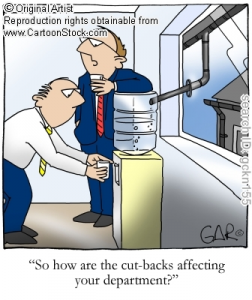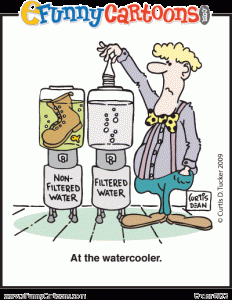There are places at your workplace. There are your desks. There are lobbies with sofas. There are places where you sit and read the newspaper. There are loos. There are smoking zones. There are coffee machines. And then there is the water cooler. A place that is frequented by just about every employee and is yet one of those non descript places that is just there. It’s one of those places that, if it is there, you wouldn’t give it a second glance (well, unless you want to drink water, or there is a good looking girl standing there) but if it is absent, you will notice it’s absence. Yet, the water-cooler has this wonderfully magnetic personality. Every time you pass by it, it draws you toward it. Somehow, your throat gets dry and you are desperately in need of a small sip of water. Mystic.
The water cooler is also one of the most interesting places on the entire campus to look at human behaviour. It evokes such oddity in human behaviour that it’s absolutely astounding to behold. Normally rational and sane people, people who are part of a species, 70% of whose body is made up of water, would exhibit such erratic behaviour when in presence of the water cooler. Allow me to illustrate:
The residue removal syndrome
Ever go to a water cooler and wait for your turn? Well, if the answer is yes, chances are that you have witnessed people with or yourself are affected by the residue removal syndrome. There is usually a common glass that people use to drink water. Now you see the guy in front using the glass to drink water.  You see clear daylight between the cup and the lip. There can be no slip. He drinks water, finishes his turn and hands over the glass to you. You smile politely, thank him and take the glass only to find that there is a little amount of water left in it. Now you have witnessed him drinking water and he hasn’t dropped dead. So, it’s safe to assume that the water is indeed safe for consumption. Yet, the small residue that remains in the glass is deemed unfit for consumption. No reason. It just is.
You see clear daylight between the cup and the lip. There can be no slip. He drinks water, finishes his turn and hands over the glass to you. You smile politely, thank him and take the glass only to find that there is a little amount of water left in it. Now you have witnessed him drinking water and he hasn’t dropped dead. So, it’s safe to assume that the water is indeed safe for consumption. Yet, the small residue that remains in the glass is deemed unfit for consumption. No reason. It just is.
So you swirl it around to check for sediments, traces of arsenic, strands of algae, left over copper filings and all related material. You are not likely to find any anyway. You make sure, just in case, and satisfy yourself that the water is indeed clean. And then what do you do? Simple. You pour the contents out. Then you flip the switch to re-fill your glass and drink it. The residue removal syndrome claims another victim. Scientists have tried to work out the rationale behind this but have thus far reached no consensus. The possible causes have been cited to be stupidness, idiocy, bone-headedness and as one scientist puts it, ‘People! Pffft!’
The less enlightened among us say, ‘It’s a water cooler wonder!’
The food court cooler
At my workplace, there are water-coolers at the food court. Now, since the population is much higher in the food court (during meal times mostly but also at other times – after all, it is an IT company with the concept of a ‘bench’), the arrangement is slightly different.  There are many glasses that are kept to prevent a long queue. Now the arrangement of these glasses is an interesting one. The glasses are kept on a two-tiered shelf. The bottom one has upturned glasses. These are the ‘fresh’ and ‘clean’ ones. They’re replaced periodically, as soon as the supply gets exhausted. Then, there is the other tier. The ‘unholy’ tier; where the ‘used’ glasses are placed, face up.
There are many glasses that are kept to prevent a long queue. Now the arrangement of these glasses is an interesting one. The glasses are kept on a two-tiered shelf. The bottom one has upturned glasses. These are the ‘fresh’ and ‘clean’ ones. They’re replaced periodically, as soon as the supply gets exhausted. Then, there is the other tier. The ‘unholy’ tier; where the ‘used’ glasses are placed, face up.
Now, people follow the following sequence:
1. Take a glass (an upturned one).
2. Proceed to the cooler (located 2 steps away)
3. Check for any impurities in the glass.
4. Satisfy yourself that there are none. In case there are, convince yourself that there are none.
5. Fill the glass with water up to the desired level.
6. Drink water.
7. Keep the glass on the ‘used’ shelf with the rim facing upwards to indicate that it has been used.
8. Walk away.
This is a sequence that is fairly common and requires little or no amount of dexterity, apart from quick thinking-on-the-feet ability and extreme decision making abilities to convince yourself that the glass is indeed clean. (Legend has it that the greatest managers of our generation have honed their decision making skills in the vicinity of a water-cooler. In fact, the famous One Minute Manager is rumored to be an extension of the water cooler management principle.) Retrace to step 6. Studies show that about 90% of the people who drink water from the cooler have a clear one foot cup-lip distance. There is no salival exchange between the living being and the cup. Yet, these glasses are considered ‘used’ and not deemed fit for future consumption. Why? Well, it’s a water cooler wonder!
<Addendum: If you try and reverse the trend by actually upturning a ‘used’ glass that is not really used, and try and put it back in the fresh glasses tier, the looks you receive are akin to the looks that a person gets when he goes to an agraharam in Kumbakonam and asks for chicken biryani.>
Yesterday’s water
One in every two employees has his own personal water bottle that he keeps at his desk. This water bottle is the subject of the incredible phenomenon of ‘yesterday’s water’. What is this? Allow me to explain.
The man walks in to the office, switches on his computer and while waiting for the system to start, goes out to refill his bottle.  Ordinarily, a simple press of the switch to fill the remainder of the bottle would suffice ( research of course proves that 97% of all water bottles in an office have water left at the end of the day). But no. The water that remains must be decanted. The reason: ‘It’s yesterday’s water. It’s not fresh.’
Ordinarily, a simple press of the switch to fill the remainder of the bottle would suffice ( research of course proves that 97% of all water bottles in an office have water left at the end of the day). But no. The water that remains must be decanted. The reason: ‘It’s yesterday’s water. It’s not fresh.’
I would like to take time out to explain the complex phenomenon that is, the water supply system: The water is present in a reservoir. This gets supplied to buildings where it is stored in tanks. It is from these that they find their way into the water cooler. It is indeed true that there is fresh water supply everyday but that does not mean that the tank is emptied every night because it contains ‘yesterday’s water.’ Home truth: The water that you fill from the water cooler is NOT today’s water. Repeat, NOT. The water may contain traces of water that might be days, weeks or even months old. What is then the reason is for disposing of ‘yesterday’s water’? Well, It’s a water-cooler wonder!
Comments
778 responses to “It’s a watercooler wonder!”
Ji Kumbakonam agraham and Chicken Biryani….. Ppl wouldnt have heard chicken biryani ji…..
Hahah! Ji You are underestimating the modernity of the agraharam ji 🙂
Lol…actually if you see, the hydrogen in your water is as old as the universe…so, that’s not even yesterday’s water… 😛
Dai!!!!! 😀
Awesome flow of presentation, dude !! Hats of to you 🙂
Thanks mate !
Flattered 🙂
Glad you liked it!
Cheers
Superbly written!! Comparison of the water cooler to a magnet was too good…
Thanks a lot machan 🙂